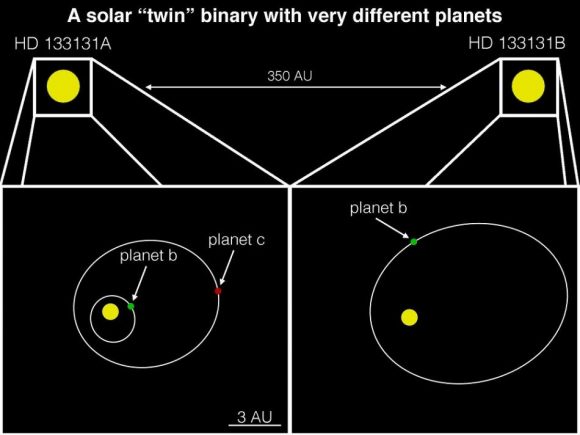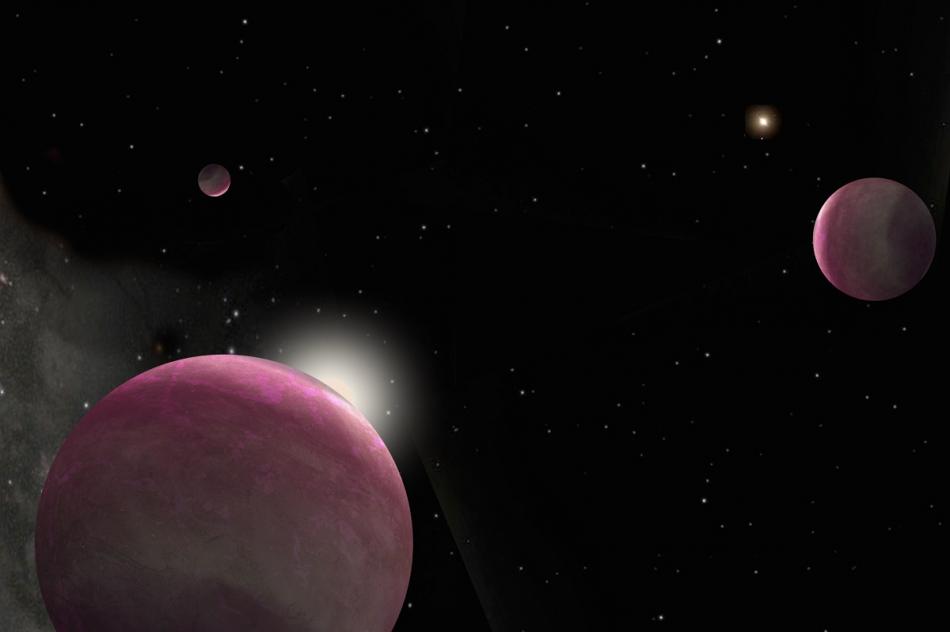The more we look, the more we see the great diversity in planetary systems around other stars. And curiously, planet hunters are finding that most star systems are very different from our own.
An example is a recently discovered system that is extremely crowded. It consists of a three giant planets in a binary (two stars) system. One star hosts two planets and the other hosts the third. The system represents the smallest-separation binary in which both stars host planets that has ever been observed.
“The probability of finding a system with all these components was extremely small,” said Johanna Teske from the Carnegie Institution for Science, “so these results will serve as an important benchmark for understanding planet formation, especially in binary systems.”

Teske and her team said this busy system might help explain the influence that giant planets like Jupiter have over a solar system’s architecture.
“We are trying to figure out if giant planets like Jupiter often have long and, or eccentric orbits,” Teske explained. “If this is the case, it would be an important clue to figuring out the process by which our Solar System formed, and might help us understand where habitable planets are likely to be found.”
The twin stars are named HD 133131A and HD 133131B. The former hosts two Jupiter-sized worlds and the latter a planet with a mass at least 2.5 times Jupiter’s. All three planets have “eccentric” or highly elliptical orbits. So far no smaller, rocky worlds have been detected but the team said those type of planets could be part of the system, or may have been part of the system in the past.
The two stars themselves are separated by only 360 astronomical units (AU – the distance between the Earth and the Sun, approximately 150,000,000 km or 93,000,000 miles). This is extremely close for twin stars with detected planets orbiting the individual stars. The next-closest known binary star system with planets has stars about 1,000 AU apart.
The two stars are more like fraternal twins rather than identical because they have slight different chemical compositions. The team said this could indicate that one star swallowed some baby planets early in its life, changing its composition slightly. Or another option is that the gravitational forces of the detected giant planets may have had a strong effect on fully-formed small planets, flinging them in towards the star or out into space.
But both stars are “metal poor,” meaning that most of their mass is hydrogen and helium, as opposed to other elements like iron or oxygen. This is another curious thing about this system, as most stars that host giant planets are “metal rich.”
The system was found using the Planet Finder Spectrograph, an instrument developed by Carnegie scientists and mounted on the Magellan Clay Telescopes at Carnegie’s Las Campanas Observatory. This finding represents the first exoplanet detection made based solely on data from the. PFS is able to find large planets with long-duration orbits or orbits that are very elliptical rather than circular.
This video tells more about the PFS:
You can read the team’s paper here. It has been accepted for publication in the Astronomical Journal.


Is there a minimum stable distance stars can orbit one another?
By stable, I’m assuming that you don’t mean parasitic either, correct?
It’s weird, but perhaps not that weird. You have a large gas cloud with a lot of angular momentum, so it partitions itself up into two stars. This takes most of the angular momentum, but you can’t destroy angular momentum, and if you have a percent or two left over, then you will have to have a giant planet. Jupiter’s orbit has about 60% of the angular momentum of the Solar System, and the Sun has about 4%. It is a bit intriguing that we have regular Jupiter-like planets, and their eccentric orbits suggest something a bit wacky was going on when they condensed. But, there ya go…
Best news here for me is that radial velocity method is now able to detect Jupiter-like planets by long observation runs, I wasn’t aware it was a thing already. The paper introduction is interesting for this.
The stars are 47 pc or 150 ly away.
Hmm trying to think of what the spectral shift pattern would be if there is a planet or planets shared between both stars.
I wonder if the eccentric orbits of the planets are true to the gravitational relationship between the binaries? i.e. Are they depicted in the orientations they are actually in as they orbit the binaries?